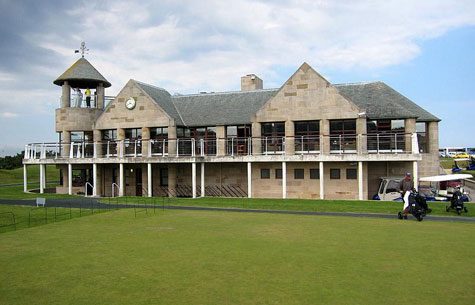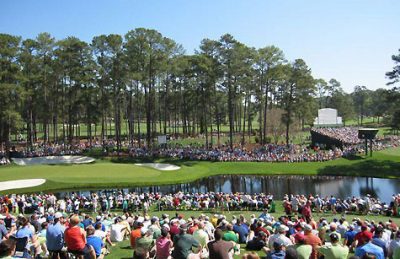St Andrews New Course Review
Categories: Course Reviews • Golf • Golf Course Architecture • Golf Courses • Golf For Women • Reviews • Travel
Tags: Balcomie Links • Course • Golf Travel • Old Course • Old Tom Morris • Scotland • St. Andrews • Travel
Now that I’ve confirmed the pending third HOG World Tour trip to St Andrews, Scotland, I can’t help having Scotland on my mind. It is a magical place. Sadly 99.999% of the courses in the United States do not play like true scottish links courses. Scottish golf is a natural, hard style of golf I far prefer to the overly-soft, over-watered, too green, over-manicured courses here in the USA.
One thing most golfers who have not been to there don’t realize is that there are a ton of courses in the town of St Andrews, not just the Old Course. That’s why I’m always giving people grief when they refer to the Old Course as St Andrews. “Hey have you played St Andrews?” they ask. I say, “which course?” St Andrews is the name of the town, not the course(s). In the town itself the other courses besides the Old Course include the New Course, Jubilee Course, Eden Course, Strathtyrum Course, The Dukes, and the Balgove Course. All but the Balgove are within walking distance. In a few minutes by car one can find even more courses: Castle Course, Torrance Course, Kittocks Course, Saint Andrews Bay Course, and Kingsbarns Golf Links.
The closest course to the Old Course is the New Course. While the Old Course dates back to around 1400, the “New” Course opened in 1895. Yeah, that’s “new” alright. The New is literally next to the Old. You can miss a fairway on the Old and the ball may end up on the New, and vice versa. I don’t recommend that though, because the New is out of bounds if you are on the Old and vice versa.
New Course Overview
Old Tom Morris is the architect of the New Course. The new is a par-71 course which tips out a 6,625 yards, short by modern standards. The new has many very similar designs and feels as the Old does, but is a little more straightforward and less quirky.
The course rating is 72.8 with a slope of 127 from the tips. For those of you in the UK, the standard scratch score (SSS) is 73. The rating would make the New just a tiny bit tougher than it’s next door neighbor, the Old.
Tee
From the tee, the new presents some great challenges. The course can be a wee bit (as they say in Scotland) tight. Errant tee shots will be penalized by bunkers, deep rough and in the worst case, gorse. If you don’t know what gorse is count yourself lucky. Gorse is a very nasty dark green bush with thorns which feasts on a strict diet of golf balls and the occasional golfer. Going into the gorse after a ball is usually not a good idea, unless you like scratching the hell out of yourself and ripping your fine golf apparel to shreds.

Some tee shots can be intimidating
Given the shorter nature of this course and the typical hard ground, driver is not necessary on many of the par-4 or even par-5 holes. The longest par-5 is 518 yards. Once again, distance isn’t the most important part of the tee shot at the New. Accuracy is.
Fairway
The fairways can be tight on the New Course, but fairly flat in most places. If the golfer has managed to avoid the pitfalls mentioned in the tee description, the approach from the fairway is fairly straightforward.

Left rough approach on the 18th hole
If the golfer misses the fairway but avoids bunkers and gorse, the rough can be very thick and inconsistent. Difficult lies in the rough may be tempting for the golfer to hit the hero shot, but it is often wise to be more conservative and get the ball back into play.
Green
The greens at the New are quite different than the Old. They’re considerably smaller and less undulating but still guarded well via bunkering and adjoining gorse and rough areas.

Because of the smaller greens, the hard ground, and the ways the greens are protected by bunkering or natural obstacles, I find the greens at the New fairly hard to hit. This puts a premium on short game. A green reached in regulation is not an overly difficult two-putt proposition like the gigantic greens on the Old.
Amenities
The St Andrews Links Clubhouse is a very spacious and large facility featuring the pro shop, Swilcan Restaurant and lockers with showers. I’ve enjoyed a few meals in the Swilcan Restaurant and knocked back some refreshing beverages while overlooking the 18th green. Such a great spot.

St Andrews Links Clubhouse
Next to the clubhouse is a nice practice green for getting the feel and working on short game. There is no driving range. The nearest range is a bit of a walk or very short drive to the St Andrews Links Golf Academy.
Tip
The St Andrews Links Trust sells a few different great golf packages. I highly recommend purchasing a three-day or seven-day “ticket.” These packages allow the golfer to play unlimited golf in either three days or seven days on the six Links Trust courses other than the Old. In the middle of the summer there is so much daylight that a hardcore golfer could literally play 3-4 rounds in ONE DAY. I’ve done the 3-day twice now and loved it. In one day I played 18 on the the Jubilee, 18 on the New, and a relaxing 9-holes on the Strathtyrum Course.
Final Thoughts
The New is a fantastic links style golf course. It’s a great course on its own and serves as an excellent alternative or backup for times when the golfer is not able to get a tee time on the Old Course. Plus the cost is a fraction of the Old.
I highly recommend experiencing the New Course when traveling to St Andrews to play golf. The New provides a tremendous and satisfying links experience.
Related Links
Balcomie Links Golf Course, Crail Scotland
Fairmont Hotel St Andrews Review
Ardgowan Hotel St Andrews Review
Old Course Caddie Walks Us Through Holes 13-18
Categories: (British) Open Championship • Golf • Golf Courses • Jordan Spieth • Pro Golf
Tags: (British) Open Championship • Old Course • St. Andrews
 This is a repost of a 2010 feature by my friend and Old Course caddie John Boyne, part three of three. Part one is here and two here. This piece covers the final six holes of The Old Course, and how a professional golfer should fare. Many thanks to Boynie for this great resource. ~Tony Korologos
This is a repost of a 2010 feature by my friend and Old Course caddie John Boyne, part three of three. Part one is here and two here. This piece covers the final six holes of The Old Course, and how a professional golfer should fare. Many thanks to Boynie for this great resource. ~Tony Korologos
13th, Hole O’ Cross (In), 465 yards, Par4
Now the golf course begins. This magnificent par four plays as the second most difficult hole on the course after the 17th Road Hole not only during the Championship but also day to day.
Old Course Caddie Walks Us Through Holes 7-12
Categories: (British) Open Championship • European Tour • PGA Tour • Pro Golf
Tags: Old Course • St. Andrews
 Note: This is part two, a repost of a 3-part walk through of The Old Course at St. Andrews by my good friend and Old Course caddie John Boyne (Boynie) of Caddie Golf Tours. I asked John to give us these hole by hole descriptions for the 2010 (British) Open Championship and he kindly obliged because, well, he’s a hell of a good guy. Check out holes 1-6 here and watch for holes 13-18 coming up next. Many thanks to Boynie for doing this special piece just for Hooked On Golf Blog ~Tony Korologos
Note: This is part two, a repost of a 3-part walk through of The Old Course at St. Andrews by my good friend and Old Course caddie John Boyne (Boynie) of Caddie Golf Tours. I asked John to give us these hole by hole descriptions for the 2010 (British) Open Championship and he kindly obliged because, well, he’s a hell of a good guy. Check out holes 1-6 here and watch for holes 13-18 coming up next. Many thanks to Boynie for doing this special piece just for Hooked On Golf Blog ~Tony Korologos
7th, High (Out), 371 yards, Par4
One of The Old Course’s quirky holes the 7th fairway criss-crosses with the tee shot for the par 3 11th with which it shares the green. Generally a lot of confusion abounds here with players waiting for others to putt out on the par 3 before they hit their approach shot to the same green. This can be the beginning of the reason why the round, of just 18 holes, will take close to six hours! Unbelievable.
Old Course Caddie Walks Us Through Holes 1-6
Categories: (British) Open Championship • Golf • Golf Courses • Pro Golf
Tags: Old Course • St. Andrews
 Note: This is a repost of a 3-part walk through of The Old Course at St. Andrews by my good friend and Old Course caddie John Boyne (Boynie) of Caddie Golf Tours. I asked John to give us these hole by hole descriptions for the 2010 (British) Open Championship and he kindly obliged because, well, he’s a hell of a good guy. Watch for the next two posts covering holes 7-12 and holes 13-18 respectively. Many thanks to Boynie for doing this special piece just for Hooked On Golf Blog ~Tony Korologos
Note: This is a repost of a 3-part walk through of The Old Course at St. Andrews by my good friend and Old Course caddie John Boyne (Boynie) of Caddie Golf Tours. I asked John to give us these hole by hole descriptions for the 2010 (British) Open Championship and he kindly obliged because, well, he’s a hell of a good guy. Watch for the next two posts covering holes 7-12 and holes 13-18 respectively. Many thanks to Boynie for doing this special piece just for Hooked On Golf Blog ~Tony Korologos
The descriptions for the holes that I summarise on the Old Course at St. Andrews will be as if the golfer has found the perfect day for golf on the links – no wind!
1st, Burn, 376 yards, Par4
Should be a relatively straight forward par 4 with the tee shot heading down the widest fairway in golf – 143 yds across the walkway Granny Clarks Wynd – No excuses for missing it really!
Old Course Time Lapse Video: Rebuilding Hell Bunker
Categories: (British) Open Championship • Golf Course Architecture • Golf Courses • Pro Golf
Tags: (British) Open Championship • Old Course • Open Championship
Welcome to Open Championship week.
Having played the Old Course several times now, I have a soft spot in my heart for any cool photos, blog posts, or video from there. The St. Andrews Links Trust keeps a blog which is one of the few golf blogs I frequent. I love seeing their updates. Today’s was fantastic, a time lapse video of the rebuild of the very daunting “Hell Bunker.” I’ve been in that bunker, once.
The riveting (the laying of sod layers to create the steep walls of the bunker) is tedious and expensive in terms of labor and money. No courses I know of in the USA do this kind of bunker work. It is very cool.
Hats off to the St. Andrews Links trust for such a neat video.
1 2 Next »












